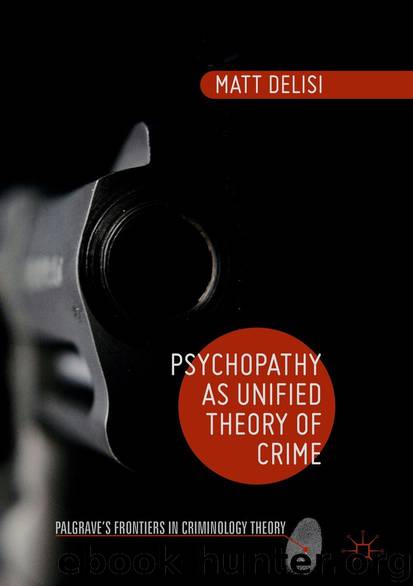Psychopathy as Unified Theory of Crime (Palgrave's Frontiers in Criminology Theory) by Matt DeLisi

Author:Matt DeLisi [DeLisi, Matt]
Language: eng
Format: epub
Publisher: Palgrave Macmillan US
Published: 2016-10-05T05:00:00+00:00
Summary
The current chapter reviewed historical attempts to describe the nomological network of behaviors and traits that corresponded to psychopathic children. Research on the development of psychopathy in childhood, adolescence, and adulthood is reviewed along with focused attention on research on the stability of psychopathic features across time and developmental stages.
What are the takeaway points? The occasional academic concern about the downward extension of psychopathy to children and adolescents was overblown and frankly overwhelmed by studies of psychopathic features among youth. The various characterological and behavioral deficits of psychopathic youth are clearly seen by children in the earliest years of life and continue across adolescence and adulthood. Even in developmental stages that are characterized by self-regulation deficits and developing sociability, psychopathic youth are detectable for their pervasive problem behaviors, aggressive and self-centered social style, and sheer negativity of their personality. Among advanced adults, psychopaths continue to commit assorted crimes, and even when there is reduced evidence of crime nevertheless evince a dysfunctional and unsuccessful lifestyle and social status. The next chapter examines the protean place of psychopathy among diverse criminal offenders and forms of antisocial conduct.
Download
This site does not store any files on its server. We only index and link to content provided by other sites. Please contact the content providers to delete copyright contents if any and email us, we'll remove relevant links or contents immediately.
Rewire Your Anxious Brain by Catherine M. Pittman(18488)
Talking to Strangers by Malcolm Gladwell(13131)
The Art of Thinking Clearly by Rolf Dobelli(10140)
Mindhunter: Inside the FBI's Elite Serial Crime Unit by John E. Douglas & Mark Olshaker(9102)
Becoming Supernatural by Dr. Joe Dispenza(8037)
Change Your Questions, Change Your Life by Marilee Adams(7564)
The Road Less Traveled by M. Scott Peck(7473)
Nudge - Improving Decisions about Health, Wealth, and Happiness by Thaler Sunstein(7458)
The Lost Art of Listening by Michael P. Nichols(7358)
Mastermind: How to Think Like Sherlock Holmes by Maria Konnikova(7161)
Enlightenment Now: The Case for Reason, Science, Humanism, and Progress by Steven Pinker(7083)
Win Bigly by Scott Adams(7032)
The Way of Zen by Alan W. Watts(6450)
Daring Greatly by Brene Brown(6367)
Big Magic: Creative Living Beyond Fear by Elizabeth Gilbert(5554)
Grit by Angela Duckworth(5446)
Ego Is the Enemy by Ryan Holiday(5226)
Men In Love by Nancy Friday(5112)
Altered Sensations by David Pantalony(5002)
